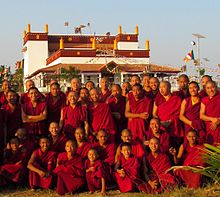| Rato Dratsang | |
|---|---|
 Rato monks in front of the temple at Rato Monastery, January 2015. | |
| Religion | |
| Affiliation | Tibetan Buddhism |
| Sect | Gelug |
| Location | |
| Location | Currently in the Tibetan Settlement, Mundgod, Karnataka, India, (originally in Central Tibet) |
| Country | India |
| Geographic coordinates | 15°01′57″N 75°00′00″E / 15.0326°N 75.00°E |
| Architecture | |
| Founder | Tak Pa Zang Bo |
| Date established | 14th century |
| Part of a series on |
| Tibetan Buddhism |
|---|
 |
Rato Dratsang (Dratsang in Tibetan means 'school' or 'university'), also known as Rato Monastery (sometimes spelled Ratö Monastery), Rato Dratsang is a Tibetan Buddhist monastery of the Gelug or "Yellow Hat" order. For many centuries, Rato Dratsang was an important monastic center of Buddhist studies in Central Tibet.
The 5th Dalai Lama, Ngawang Lobsang Gyatso (1617–1682), referred to Rato Dratsang as Taktsang, or Tiger Nest, because of its fine scholars and debaters. The monastery served as a center for the study of Buddhist philosophy and logic; monks from many other monasteries came to Jang, under Rato’s authority, every year to intensively study and rigorously debate logic.
After 1959, Rato Dratsang was reestablished in a Tibetan Refugee Settlement in Mundgod, Karnataka State, in southern India. The original Rato Dratsang exists in Tibet.
In 1985, the Rato Dratsang Foundation, was established as a 501(c)(3) nonprofit organization to help the monastery flourish and grow.
In 2012, the Dalai Lama appointed a westerner monk, Nicholas Vreeland, to be Rato Dratsang’s new Abbot. [1][2][3][4][5]
- ^ Religious News Services, 8 May 2012, Dalai Lama Appoints Ven. Nicholas Vreeland as Abbot of Rato Monastery in India - First Time Westerner Becomes Head of a Tibetan Monastery [1] Accessed 2014-6-1
- ^ Vreeland, Nicholas. "Photos for Rato". tricycle.org. Tricycle. Retrieved 10 March 2018.
- ^ Lawton, Kim (June 15, 2012). "Buddhist Abbot Nicholas Vreeland". Religion and Ethics Weekly, PBS. Retrieved 10 March 2018.
- ^ Alvarez, Lizette (May 19, 2010). "Even the Dalai Lama Has a Point Man". The New York Times. Retrieved 10 March 2018.
- ^ Elder, Sean (December 11, 2014). "Nicky Vreeland: The Playboy and the Prayer Wheel". Newsweek. Retrieved 10 March 2018.

